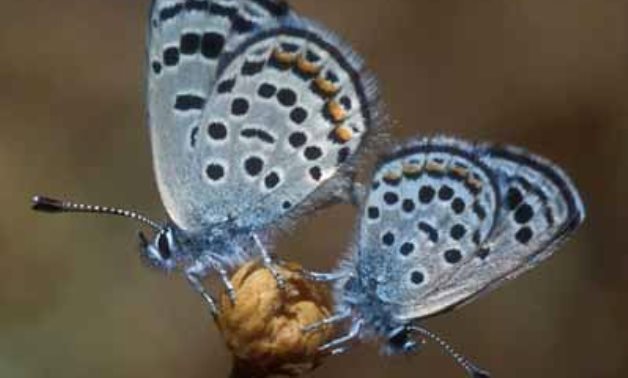
Sinai Baton Blue Butterfly - Twitter
CAIRO - 11 August 2022: The climate change has negatively affected living organisms, causing unjustified migration of some marine organisms, and endangering species of butterflies.
One of these butterflies inhabiting only on mountainside patches of wild thyme in an arid corner of the Sinai Peninsula in Egypt; Saint Katherine Protectorate. It is considered the smallest butterfly in the world, said Dr. Lydia Mohamed Kamel, Director General of the General Administration for Climate Change Technology and Research at the Central Administration for Climate Change at the Ministry of Environment.
It is called "Pseudophilotes sinaicus" or the Sinai Baton Blue Butterfly.
Dr. Lydia Kamel gave a speech Thursday at the National Youth Dialogue meeting held at the headquarters of the Ministry of Environment, where she explained that this butterfly is threatened by temperatures and reduced food where she lives.
In this report, et discusses 11 most important information about this butterfly:
1- It is called the small Sinai blue butterfly, and it is the smallest butterfly in terms of size and its length is between 14-18 millimeters.
2- The ventral side of its wing is full of dark spots and about 40% of the hair on the wing is black.
3- There are orange spots on the hind wing
4- It is endemic to Saint Catherine Reserve in South Sinai
5- It lives in high places in the mountains
6- It is not found in any other place in the world other than this region.
7- It lives and feeds on the thyme plant, and its larvae feed on the buds of the plant.
8- The whole butterfly feeds on the nectar of thyme flowers.
9- The thyme plant itself is one of the plant species that appears on the summits of the Saint Catherine Mountains, in small areas, and it is found only in this place, which is about 1,800 meters above the surface of the earth.
10- The little butterfly is threatened with extinction due to global warming and climate change
11- Climate change leads to its rapid exposure to the risk of extinction due to drought, which damages the stability of the thyme plant on which the butterfly feeds, which causes a decrease in the number of butterflies.
Comments
Leave a Comment